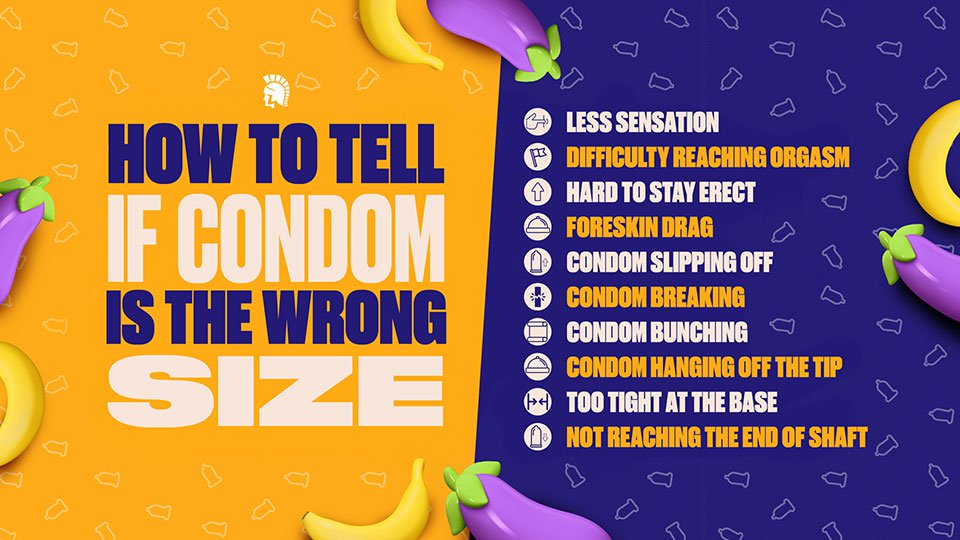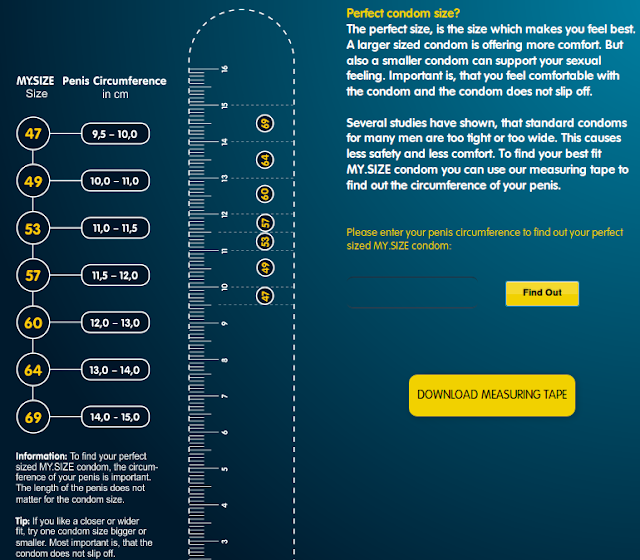Condom Size Calculator: A Comprehensive Guide To Finding The Perfect Fit
Finding the right condom size is crucial for comfort, safety, and satisfaction during intimate moments. Many people overlook the importance of sizing, but using the wrong size can lead to discomfort or even accidents. A condom size calculator can help you determine the perfect fit based on your measurements and preferences.
Sexual health is an essential aspect of overall well-being, and using the appropriate protection is vital. Whether you're new to using condoms or have been using them for years, understanding how to measure and select the correct size can make a significant difference in your experience. A condom size calculator simplifies this process by providing personalized recommendations.
In this article, we will explore everything you need to know about condom size calculators, including how they work, the factors that affect sizing, and tips for ensuring a secure and comfortable fit. By the end of this guide, you'll be equipped with the knowledge to make informed decisions about your sexual health.
Read also:Damn Reincarnation Season 3 Unveiling The Next Chapter Of Supernatural Thrills
Table of Contents
- What is a Condom Size Calculator?
- Why Should You Use a Condom Size Calculator?
- How to Measure for a Condom Size Calculator
- Types of Condoms and Sizes
- Factors Affecting Condom Size
- Benefits of Using the Right Condom Size
- Common Mistakes to Avoid When Using a Condom Size Calculator
- Tips for Selecting the Right Condom Size
- Frequently Asked Questions About Condom Size Calculators
- Conclusion: Why a Condom Size Calculator Matters
What is a Condom Size Calculator?
A condom size calculator is a tool designed to help individuals determine the appropriate condom size based on specific measurements. This tool considers factors such as girth and length to recommend the best fit. While condoms are generally categorized into standard, large, and snug sizes, a calculator provides more personalized results by analyzing individual data.
Using a condom size calculator ensures that you select a product that fits comfortably and securely, reducing the risk of slippage or breakage. This tool is particularly useful for those who may not be familiar with the nuances of condom sizing or prefer a more tailored approach to their sexual health.
Why Should You Use a Condom Size Calculator?
Selecting the right condom size is essential for several reasons:
- Comfort: A well-fitting condom enhances the experience by ensuring comfort during use.
- Protection: Properly sized condoms reduce the likelihood of slippage or tearing, which can compromise safety.
- Confidence: Knowing that you have the right size can boost confidence and improve overall satisfaction.
- Effectiveness: Correctly fitting condoms are more effective at preventing pregnancy and sexually transmitted infections (STIs).
By using a condom size calculator, you can avoid common sizing issues and enjoy a more satisfying and secure experience.
How to Measure for a Condom Size Calculator
Step-by-Step Guide to Measuring
Accurate measurements are key to obtaining the right recommendations from a condom size calculator. Follow these steps to measure correctly:
- Girth Measurement: Measure the circumference at the base of the penis using a flexible measuring tape. Record the measurement in millimeters or inches.
- Length Measurement: Measure the length from the base to the tip of the penis when fully erect. Record this measurement as well.
- Compare Results: Input the measurements into the condom size calculator to receive personalized size recommendations.
It's important to measure when fully erect to ensure the most accurate results. This will help you choose a condom that fits snugly without being too tight or loose.
Read also:Understanding The Art Of Point In Wood Techniques Benefits And Applications
Types of Condoms and Sizes
Understanding Condom Size Categories
Condoms are typically categorized into three main size groups:
- Standard: Suitable for most individuals, standard condoms have a width of approximately 52mm.
- Large: Designed for those who require extra room, large condoms typically have a width of 56mm or more.
- Snug: For a tighter fit, snug condoms usually have a width of around 49mm.
Additionally, some brands offer specialty sizes and shapes to cater to specific preferences. Always check the packaging for detailed size information to make an informed choice.
Factors Affecting Condom Size
Physical and Personal Considerations
Several factors influence condom size requirements:
- Anatomy: Individual body structure and measurements play a significant role in determining the right size.
- Comfort Preferences: Some users prefer a looser or tighter fit based on personal comfort levels.
- Brand Variations: Different brands may have slight variations in sizing, so it's important to test different options.
- Material: The material of the condom can affect elasticity and fit, which should be considered when choosing a size.
By accounting for these factors, you can ensure a better fit and more enjoyable experience.
Benefits of Using the Right Condom Size
Why Fit Matters
Using the correct condom size offers numerous advantages:
- Enhanced Safety: Properly fitting condoms are less likely to slip or break, providing better protection.
- Increased Comfort: A well-fitted condom reduces irritation and discomfort during use.
- Better Performance: The right size ensures that the condom stays in place and functions effectively.
- Improved Confidence: Knowing that you have the correct size can boost self-assurance during intimate moments.
Investing time in finding the right fit can lead to a more satisfying and secure experience.
Common Mistakes to Avoid When Using a Condom Size Calculator
Pitfalls to Watch Out For
While condom size calculators are helpful tools, there are some common mistakes to avoid:
- Inaccurate Measurements: Ensure that you measure correctly to receive accurate recommendations.
- Ignoring Brand Differences: Recognize that sizing can vary slightly between brands and adjust accordingly.
- Overlooking Material: Consider the material and elasticity of the condom when selecting a size.
- Assuming One Size Fits All: Understand that different individuals may require different sizes, even within the same relationship.
Avoiding these mistakes will help you make the most of your condom size calculator experience.
Tips for Selecting the Right Condom Size
Practical Advice for Finding the Perfect Fit
Here are some tips to help you choose the right condom size:
- Experiment with Different Brands: Try various brands to see which offers the best fit and comfort.
- Consider Lubrication: The type of lubrication can affect how a condom feels, so choose one that complements your preferences.
- Check Expiry Dates: Ensure that the condoms you purchase are within their expiration dates for optimal performance.
- Seek Professional Guidance: If unsure, consult a healthcare professional or pharmacist for personalized advice.
By following these tips, you can enhance your experience and ensure better protection.
Frequently Asked Questions About Condom Size Calculators
Answers to Common Queries
Here are some frequently asked questions about condom size calculators:
- Q: Is a condom size calculator accurate? A: While calculators provide personalized recommendations, slight variations may occur due to individual differences.
- Q: Can I use the same size for all brands? A: Not necessarily, as sizing can vary slightly between brands. Always check the packaging for specific measurements.
- Q: What if I can't find my exact size? A: If your measurements fall between sizes, choose the closest option and test it for comfort and fit.
- Q: Are specialty condoms worth trying? A: Specialty condoms can offer unique features, but it's important to ensure they fit properly and meet your needs.
These answers should address common concerns and help you make informed decisions about your condom size choices.
Conclusion: Why a Condom Size Calculator Matters
In conclusion, using a condom size calculator is a practical and effective way to determine the right fit for your needs. By considering factors such as girth, length, material, and personal preferences, you can enhance your experience and ensure better protection. Remember that finding the right size is a personal journey, and it may take some experimentation to discover what works best for you.
We encourage you to share your thoughts and experiences in the comments below. Additionally, feel free to explore other articles on our site for more information on sexual health and wellness. Together, we can promote safer and more satisfying intimate experiences for everyone.
Data Source: World Health Organization and Centers for Disease Control and Prevention.
Article Recommendations


